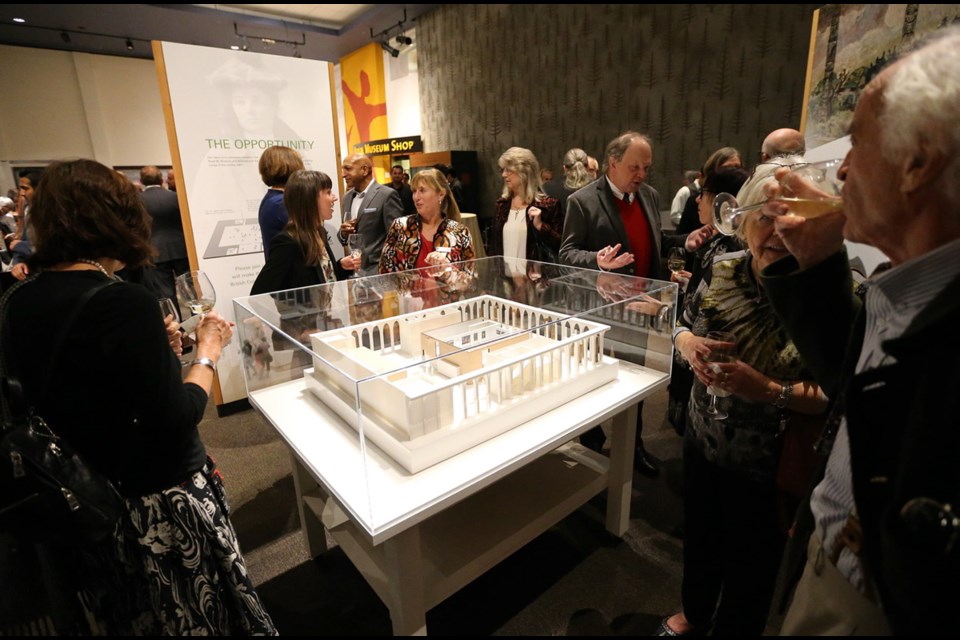As most Royal B.C. Museum visitors know, a lot has changed since a citizens’ petition inspired its creation in 1886.
Despite this provincial treasure’s steady expansion, however, some things haven’t changed, guests at a reception celebrating its 130th anniversary in the refurbished Newcombe Conference Hall were told last Tuesday.
“The government was being lobbied then, and I want you to know you’re being lobbied now,” said B.C. Minister of Community, Sport and Cultural Development Peter Fassbender.
He prompted laughter while recalling what museum CEO Jack Lohman once told him before pledging the province’s continued support for what he termed “an amazing jewel.”
Fassbender was in a jovial mood, joking before his address that he hoped he wouldn’t be mistaken for dashing film star Michael Fassbender, which was how he was recently introduced at a wedding.
“I’m not kidding,” Fassbender said. “The emcee didn’t know me. I said, ‘I don’t look as good as him, either with my clothes on, or with my clothes off.”
When Lohman wasn’t graciously welcoming his guests and sharing his vision, the diplomatic CEO revealed his own sense of humour.
Displaying the 1886 petition that he said Matthew Baillie Begbie “galvanized citizens 130 years ago to sign,” Lohman noted that one of the “superb and illustrious names” on it was Shakespeare.
“Not that one!” he quipped. “It was Noah Shakespeare, who was a relative, I understand, during the Cariboo gold rush. I understand he didn’t write as well as his ancestor.”
Lohman said he has always felt there were three turning points in the museum’s history — “four if you include the appointment of Peter Fassbender as minister of culture.”
They were the decision to rebuild the museum as part of Canada’s centennial; the merger with the B.C. Archives in 2003, which meant the museum would acquire more than 1,000 pieces of art by B.C. artist and author Emily Carr; and the discovery of the Douglas treaties in the B.C. Archives.
Lohman also showcased letters from Prime Minister Justin Trudeau and Heritage Minister Melanie Joly.
There was no shortage of illustrious guests at the reception, which continued in the Clifford Carl Hall, where some rarely-seen museum treasures were displayed. Highlights included five Carr paintings, including Tanoo Q.C.I., and a ballot box from the 1930s that Lohman said “speaks to women getting the vote.”
Notable guests included Brazilian Consul-General Ernesto Rubarth; Sister Patricia Donovan of the Congregation of the Sisters of St. Ann; former museum CEO Pauline Rafferty; Axel Meisen, past president of the Canadian Commission for UNESCO; B.C. artist, storyteller and philanthropist Arthur Vickers; and former corporate board chairman John Walton.
Stefan and Magda Opalski, who after restoring Wentworth Villa will soon open their Architectural Heritage Museum, reiterated their gratitude to RBCM, and particularly archivist Frederike Verspoor for her assistance.
Said Magda: “She was merging several archives that frankly, for a non-initiated person, is challenging. It’s an old system, very chaotic with various catalogues. She tutored us.”
After tipping his hat to the historic work of the museum’s curators, scholars, archivists, technicians and more, Lohman expressed excitement about what lies ahead in the digital age.
“Digital technology means researchers and scholars can have access to absolutely everything,” he said.
“We’re trying to achieve a very vibrant dynamic. You’ve got to digitize everything, but of course that is going to take some time.”
He said the impact of being highly-rated online through sites such as Trip Advisor cannot be underestimated. “You cannot ignore social media, especially when you’re trying to create a museum that touches everybody.”
It’s all part of enhancing the appeal and longevity of a knowledge institution that he said is an integral part of the creative economy.
“Our ambition is to create one of the best museums in the world, and we won’t stop until we’ve done it.”



